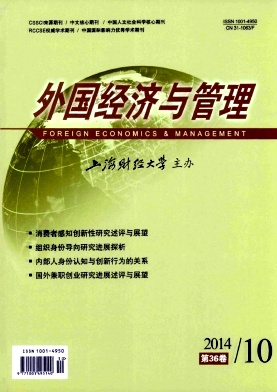组织身份导向研究进展探析
外国经济与管理 2014 年 第 36 卷第 10 期, 页码:22 - 31
摘要
参考文献
摘要
组织身份导向是指组织成员关于组织与利益相关者关系性质的共享知觉,或者说组织成员关于组织如何定义其社会自我的共享知觉。本文从组织身份导向概念的形成和内涵、组织身份导向与组织社会价值贡献、组织身份导向与组织关系管理模式以及组织身份导向与相关变量的关系等方面对现有文献进行了梳理,并对未来研究方向进行了展望。作为组织身份理论的扩展,组织身份导向理论有助于解释组织与其他组织特别是与利益相关者之间的关系,对于解释组织承担社会责任的动机也有着重要价值。
[1]Shavelson R J,Hubner J J and Stanton G C.Self-concept:Validation of construct interpretations[J].Review of Educational Research,1976,46(3):407-441.
[2]Marsh H W and Shavelson R J.Self-concept:Its multifaceted,hierarchical structure[J].Educational Psychologist,1985,20(3):107-125.
[3]Byrne B M.The general/academic self-concept nomological network:A review of construct validation research[J].Review of Educational Research,1984,54(3):427-456.
[4]Markus H R and Kitayama S.Culture and the self:Implications for cognition,emotion,and motivation[J].Psychological Review,1991,98(2):224-253.
[5]Brewer M B and Gardner W.Who is this“we”?Levels of collective identity and self representations[J].Journal of Personality and Social Psychology,1996,71(1):83-93.
[6]Brickson S L.The impact of identity orientation on individual and organizational outcomes in demographically diverse settings[J].Aca-demy of Management Review,2000,25(1):82-101.
[7]Brickson S L.Organizational identity orientation:Forging a link between organizational identity and organizations’relations with stakeholders[J].Administrative Science Quarterly,2005,50(4):576-609.
[8]Albert S and Whetten D A.Organizational identity[A].in Staw B M and Cummings L L(Eds.).Research in organizational behavior[C].Greenwich,CT:JAI Press,1985,7:263-295.
[9]Tajfel H and Turner J C.An integrative theory of intergroup conflict[A].in Austin W G and Worchel S(Eds.).The social psychology of intergroup relations.monterey[C].Monterey CA:Brooks/Cole,1979:33-47.
[10]Turner J C.Towards a cognitive redefinition of the social group[A].in Tajfel H(Ed.).Social identity and intergroup relations[C].Cam-bridge,UK:Cambridge University Press,1982:15-40.
[11]Brickson S L.Organizational identity orientation:The genesis of the role of the firm and distinct forms of social value[J].Academy of Management Review,2007,32(3):864-888.
[12]Walker L J and Henning K H.Differing conception of moral exemplarity:Just,brave,and caring[J].Journal of Personality and Social Psychology,2004,86(4):629-647.
[13]Basu K and Palazzo G.Corporate social responsibility:A process model of sense-making[J].Academy of Management Review,2008,33(1):122-136.
[14]Christmann P and Taylor G.Firm self-regulation through international certifiable standards:Determinants of symbolic versus substantive implementation[J].Journal of International Business Studies,2006,37(6):863-878.
[15]Wickert C and Vaccaro A.Organizational identity orientation and the adoption of corporate social responsibility:Symbolic,selective,or substantial?[R].UZH Business Working Paper Series,Number 318,2012.
[16]Li J,Tang G-Y and Chen Y.Firms’human resource in information system and sustainable performance:Does their organizational identity matter?[J].Journal of Human Resource Management,2012,23(18):3838-3855.
[17]Bingham J B,Gibb Dyer Jr W,Smith I and Adams G L.A Stakeholder identity orientation:Approach to corporate social performance in family firms[J].Journal of Business Ethics,2011,99(4):565-585.
[18]Vos M and Van der Zee K.Prosocial behavior in diverse workgroups:How relational identity orientation shapes cooperation and hel-ping[J].Group Processes&Intergroup Relations,2011,14(3):363-379.
[19]Eckel C C and Grossman P J.Managing diversity by creating team identity[J].Journal of Economic Behavior&Organization,2005,58(3):371-392.
[20]Ellemers N,Sleebos E,Stam D,et al.Feeling included and valued:How perceived respect affects positive team identity and willingness to invest in the team[J].British Journal of Management,2013,24(1):21-37.
[2]Marsh H W and Shavelson R J.Self-concept:Its multifaceted,hierarchical structure[J].Educational Psychologist,1985,20(3):107-125.
[3]Byrne B M.The general/academic self-concept nomological network:A review of construct validation research[J].Review of Educational Research,1984,54(3):427-456.
[4]Markus H R and Kitayama S.Culture and the self:Implications for cognition,emotion,and motivation[J].Psychological Review,1991,98(2):224-253.
[5]Brewer M B and Gardner W.Who is this“we”?Levels of collective identity and self representations[J].Journal of Personality and Social Psychology,1996,71(1):83-93.
[6]Brickson S L.The impact of identity orientation on individual and organizational outcomes in demographically diverse settings[J].Aca-demy of Management Review,2000,25(1):82-101.
[7]Brickson S L.Organizational identity orientation:Forging a link between organizational identity and organizations’relations with stakeholders[J].Administrative Science Quarterly,2005,50(4):576-609.
[8]Albert S and Whetten D A.Organizational identity[A].in Staw B M and Cummings L L(Eds.).Research in organizational behavior[C].Greenwich,CT:JAI Press,1985,7:263-295.
[9]Tajfel H and Turner J C.An integrative theory of intergroup conflict[A].in Austin W G and Worchel S(Eds.).The social psychology of intergroup relations.monterey[C].Monterey CA:Brooks/Cole,1979:33-47.
[10]Turner J C.Towards a cognitive redefinition of the social group[A].in Tajfel H(Ed.).Social identity and intergroup relations[C].Cam-bridge,UK:Cambridge University Press,1982:15-40.
[11]Brickson S L.Organizational identity orientation:The genesis of the role of the firm and distinct forms of social value[J].Academy of Management Review,2007,32(3):864-888.
[12]Walker L J and Henning K H.Differing conception of moral exemplarity:Just,brave,and caring[J].Journal of Personality and Social Psychology,2004,86(4):629-647.
[13]Basu K and Palazzo G.Corporate social responsibility:A process model of sense-making[J].Academy of Management Review,2008,33(1):122-136.
[14]Christmann P and Taylor G.Firm self-regulation through international certifiable standards:Determinants of symbolic versus substantive implementation[J].Journal of International Business Studies,2006,37(6):863-878.
[15]Wickert C and Vaccaro A.Organizational identity orientation and the adoption of corporate social responsibility:Symbolic,selective,or substantial?[R].UZH Business Working Paper Series,Number 318,2012.
[16]Li J,Tang G-Y and Chen Y.Firms’human resource in information system and sustainable performance:Does their organizational identity matter?[J].Journal of Human Resource Management,2012,23(18):3838-3855.
[17]Bingham J B,Gibb Dyer Jr W,Smith I and Adams G L.A Stakeholder identity orientation:Approach to corporate social performance in family firms[J].Journal of Business Ethics,2011,99(4):565-585.
[18]Vos M and Van der Zee K.Prosocial behavior in diverse workgroups:How relational identity orientation shapes cooperation and hel-ping[J].Group Processes&Intergroup Relations,2011,14(3):363-379.
[19]Eckel C C and Grossman P J.Managing diversity by creating team identity[J].Journal of Economic Behavior&Organization,2005,58(3):371-392.
[20]Ellemers N,Sleebos E,Stam D,et al.Feeling included and valued:How perceived respect affects positive team identity and willingness to invest in the team[J].British Journal of Management,2013,24(1):21-37.
引用本文
刘云. 组织身份导向研究进展探析[J]. 外国经济与管理, 2014, 36(10): 22–31.
导出参考文献,格式为:
上一篇:搜索引擎营销研究综述及展望





 6046
6046  643
643

